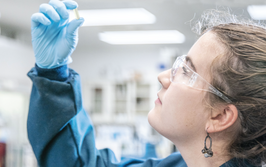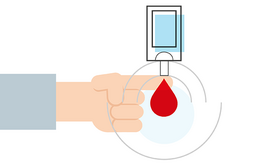Catalyzing Success
Biocatalysis can bring many benefits to drug synthesis, but can enzyme immobilization enhance the process further?
Biocatalysis – the use of natural substances (usually enzymes) to speed up chemical reactions – has roots stretching all the way back to ancient Mesopotamia, where it was used for the manufacture of food and drink. Somewhat more recently, the pharma industry has become interested in using enzymes to catalyze drug synthesis reactions to eliminate the need for high temperatures and polluting solvents. The snag for pharma companies is that unless enzymes are immobilized, they cannot be reused, which is crucial for economic viability. But if they are immobilized, they tend to lack stability – which is also key. How can this conundrum be addressed?
Stéphane Corgié founded Zymtronix in 2013 after finding a way to immobilize enzymes without sacrificing stability or productivity. The company is in its early stages, but Corgié has set his sights on revolutionizing pharma manufacturing, drug discovery, and agriculture. We find out more from Corgié.
What’s the history and presence of biocatalysis in the pharma industry?
Biocatalysis involves using natural substances to speed up chemical reactions. It underpins some of the oldest and most important production processes, including the production of wine and cheese. It was at the beginning of the last century – thanks to experiments carried out by Ludwig Rosenthaler in the early 1990s – when scientists recognized that biological components could be used to induce chemical transformations. Then, with the advent of protein engineering in the 1980s, which widened the library of enzymes available as catalysts, plus subsequent improvements in molecular biology, scientists began to see the potential of using enzymes to enhance drug production. Biocatalysts have high selectivity and tend to require milder reaction conditions, which leads to a number of advantages in chemical production, including greater yields and lower costs. Biocatalysis started to be used on an industrial scale in 2002 when DSM used engineered lipases in the production process for diltiazem. With the rapid development of protein engineering since, several classes of enzymes have now evolved for use in drug production.
The biggest drawbacks of biocatalysis are the time and complexities involved in designing an adequate biocatalyst – although this is improving as the industry gains more experience and designs new tools to evolve enzymes. When you use the right enzymes, biocatalysis allows you to collapse several synthetic steps into one. Enzymes are also reusable, biodegradable and are Generally Regarded as Safe (GRAS). In addition to the lowered environmental footprint because of the reduced need for solvents and toxic chemicals, the reactions typically work at room temperature, so require less energy.
What we’ve seen so far in the pharma industry is, by and large, cost savings and process improvement driving the development of enzymes for manufacturing. At the end of the day, enzymes are proteins and are expensive, so cost saving needs to be consequential to trigger the adaption of enzymes as a new manufacturing method. However, many companies are beginning to realize that using numerous solvents and industrial chemocatalysts is quite expensive, even compared with the proteins used in biocatalysis. Moreover, biological catalysts are much faster and more selective than, for instance, metal catalysts – especially on complex chiral molecules.
For green chemistry approaches to be used more widely across industry, especially at scale, the benefits of enzymes need to be demonstrated in terms of both speed and cost – and that’s already started with some big companies, such as Pfizer and Merck.
What are the challenges of working with biocatalysts at an industrial scale?
An effective enzyme catalyst doesn’t necessarily make a good process. Although enzymes are more efficient than traditional chemocatalysis, they can be difficult to use in industrial conditions – they are proteins after all. The main challenge is making sure that the performance and cost at scale are significantly lower than what would be achieved with regular chemistries and catalysts.
Timing is also everything. Once the decision has been made to push a molecule to market, pharma companies must be able to quickly demonstrate, optimize and implement production of the molecule, and understand how to maximize production when in process. This means that enzymes not only compete against other technologies, but also against time – every day your product is not on the market, you are losing money. If it takes years to develop the right enzymes and the right process versus adopting classic chemistry solutions, then companies will always choose the latter. With current biomolecular tools, enzymes can now be evolved fast enough to stand a chance against other chemistries. I hope that my company can help speed things along by providing the next step. We are giving enzymes an extra boost at the start with a toolbox that quickly finds the best parameters to achieve peak performance.
What’s the story behind Zymtronix?
I started out investigating the use of enzymes for high-value chemicals from plant feedstocks at Cornell University. At the time in the US, there were a number of programs aimed at converting biomass into fuels, but I was interested in doing other things with biomass. There are many different chemical fractions in plants, with the one used for biofuel production having the lowest commercial value. Other fractions contain the building blocks for higher value chemicals. One example is lignin. Maximizing the use of biomass and going after these molecules makes economic sense, but lignin is a very stable plant polymer and very difficult to degrade – only some species of fungi have the enzyme system to do so. Our goal was to develop a new biocatalytic approach to enable commercial use of these enzymes. Immobilizing the enzymes to make them reusable was a first step; we developed materials that trap these enzymes and started to assay them. We discovered that we were also increasing their potential upon immobilization and making them less prone to inhibition at the same time, which is the main problem when using these enzymes in such applications. Finally, we were able to depolymerize lignin into small aromatic molecules using our immobilized and stabilized peroxidase enzymes. We then started to look at what our technology platform could do for other enzymes, as well as boosting performance upon immobilization.
What’s different about your immobilization technology?
Enzyme immobilization (the process by which enzymes are physically or chemically coupled on a material to make them insoluble so that they can be easily separated from solution), allows the reuse of biocatalysts, and thus reduces the cost of goods. There are different approaches to immobilizing enzymes, including adsorption, cross-linking, and molecular entrapment; however, the main drawbacks of these methods is that they result in the loss of activity of a percentage of the enzymes – the drop in enzyme activity can be anything between 10 to 90 percent. Clearly, when you buy one kilo of enzymes you don’t want only 10 percent to be active.
Our approach is different. We let our material build itself around the enzymes so that they can be perfectly fitted. We implemented a process to find the optimal way to immobilize and prevent loss of activity. We started with peroxidase and once we immobilized the enzymes we saw a dramatic and unexpected jump in activity. We observed similar behavior with other oxidative enzymes – and that became the basis of Zymtronix! To prove the technology worked, we purchased some enzymes from other families that were already being used in pharma process chemistry and immobilized them. Although we did not see a jump in activity in all the cases, we were able to maintain full activity. On top of this, the materials we use are highly magnetic so the enzymes can be easily captured.
After patenting the technology, we had to figure out what to do with it. Various industries use biocatalysis, but we were initially drawn to pharma because many of the active ingredients are chiral, and so very well suited to enzymes (which are also chiral molecules). Our goal is to offer a universal, high-performance yet flexible solution to fit in with clients’ process needs. Demonstrating the stability of the materials is key when dealing with pharma companies, so we have collaborated with a team of chemical engineers at Rutgers University for third party validation. We are focusing on those oxidations that can solve many problems in the pharma industry – and other industries more broadly. In particular, we’re focusing on hydroxylation – and we think we can make a big difference.
How else are you using immobilized enzymes?
Our bodies transform and eliminate dangerous or foreign chemical compounds – including drugs – using a battery of enzymes. The resulting metabolites can be more active and potentially more toxic than the drug itself. Regulatory agencies and drug innovators use an array of in-vitro tests to make sure drugs are safe before starting clinical trials and marketing them; however, one of the bottlenecks is producing and screening the metabolites that our bodies produce. We are developing high-throughput metabolism assays using immobilized and stabilized human metabolic enzymes. A better understanding of the enzymes involved in drug metabolism could be a game changer in drug development as it would enable more accurate predictions of toxicity and risks.
Outside of pharma (but perhaps interesting for readers anyway), we are also working within the agricultural industry to offer a cleansing solution based on stabilized biocidal and fungicidal enzymes. Few people are aware that, although many vegetables are grown in the US, the seeds are often imported. Plant pathogens can travel on the seeds from production plants in other countries and during stringent border sanitary inspection, many seeds are destroyed. We are developing a solution that could sanitize whole batches of seeds by killing a broad range of bacteria and fungi without affecting the viability of the seeds – especially sensitive ones. We borrowed some plant pathogens from the Plant Science department at Cornell to test our theory and, fortunately, our experimental formulation worked the first time around! Since then, we have been developing our formulations in vitro against a broad array of fungi and bacteria to show that they are compatible with other active ingredients and, importantly, don’t harm the seeds.
The Business of Biocatalysis
The jump from academia to business has certainly been a challenge. The days are very long (and sleep is never overrated), but it’s been an interesting transition. When you are working in academia, you have an infrastructure all around you, but when starting your own company you have to think about things that have never crossed your mind, such as business plans, taxes, contracts and finding consultants to help you through the process. In any business, having a good team is vital. For example, Zymtronix co-founder, Juan Diego Alonso, who has a law degree and business degree from Cornell, has been essential in setting up Zymtronix and helping the company grow. We first met in an entrepreneurship class at the Johnson Business School at Cornell and, coincidently, he was also reviewing our technology for Cornell Tech Transfer! We incorporated Zymtronix soon after.
When we started the company, we didn’t have much money so we decided to enter some business competitions. Competitions are a fantastic way to test your pitch and your ideas, improve your team dynamic and, probably most importantly, build your network of connections. In the first year, we didn’t win any competitions but it was an important learning curve. I had to stop talking science and start talking business. And now we have won a number of awards, including the Cornell MSE Competition, the 2015 Mai Bangkok Business Challenge in Thailand, and the 2015 New York Business Plan Competition, as well as reaching the finals of various others.
One of our biggest challenges has been creating a brand. We had lots of different ideas but organizing them into a single message and selling that message was difficult. Finding our PR agency (Notch Communications), though not high on my priority list when I started the company, proved invaluable when it came to our tagline – “Next Wave Biocatalysis” – and finding our identity and voice. Once you have a voice it makes running a business much easier.
What’s next for the company?
So far, most of the enzyme processes that we have addressed have been fairly rudimentary; one enzyme, one reaction. But I want Zymtronix to become a new way of thinking about enzymes in processes! We have recently demonstrated that entire systems of enzymes, including co-factor recycling, can be quickly optimized and scaled-up with the added benefit of being reusable. In essence, we are trying to open new doors to synthetic biochemistry with increasingly more complex and elegant processes – by using enzymes the way biological systems do. Imagine the ability to engineer entire pathways within stable materials that can be reused without having to compromise with the constraints of living things. For me, that is next wave biocatalysis.


















